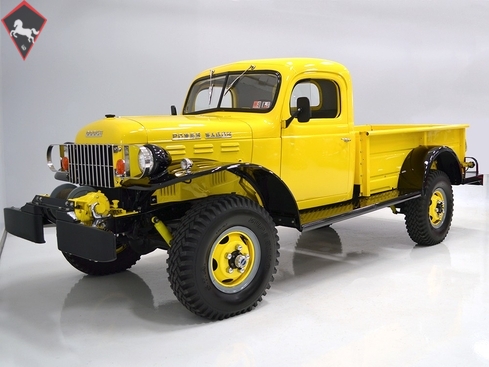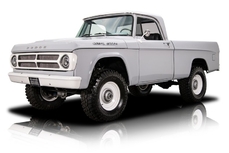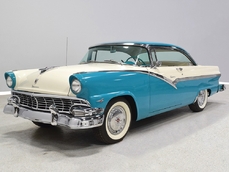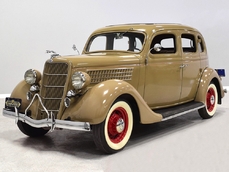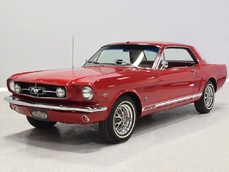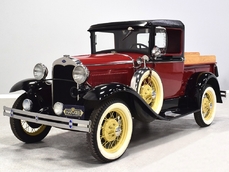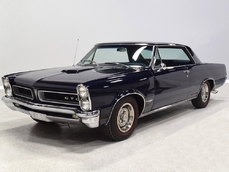Dodge Power Wagon 251 cubic inch inline-6 1967
General description :
Who would have thought that a simple Dodge Power Wagon would someday be mentioned in the same breath as the Mercedes SL and Jaguar XKE? But in recent years, those three vehicles have enjoyed a staggering increase in appreciation and values, perhaps more than any other mass-produced machines on the market today. Why? It’s hard to say, but we frequently see awesome vehicles that stay off enthusiasts’ radars for decades only to be suddenly discovered, and that’s certainly the case with the Power Wagon. They’re basic, make no mistake, but they’re also some of the most capable off-road machines ever designed and the look as perhaps the ultimate expression of form following function. There’s just nothing else like a Power Wagon.
Which brings us to this 1967 Dodge Power Wagon, which just might be the nicest stock Power Wagon we’ve ever seen. If you know us, you know that we sell more Power Wagons than just about anyone else, so that’s no faint praise. Late Power Wagons like this are the most desirable of all, because they feature numerous upgrades that were integrated over the years, including a larger engine, 12-volt electrical system, synchromesh transmission, and other details, all of which make these the ones to own if you’re a serious collector. As the recipient of a frame-off restoration by a knowledgeable Power Wagon owner with multiple trucks, it’s beautifully finished and definitely attracts attention wherever it goes, which is what Power Wagons do better than almost any other vehicle in the world. With just test and tune miles on it, this is as good as Power Wagons get.
There’s no question that this big yellow Dodge is far nicer in every single way than when it was new, but if you want one that’s ready to sit on the show field with the other restored pieces of art, this is it. We see very few restored to this level because, let’s face it, its days of playing in the dirty are completely over. The Chrome Yellow paint is from the Ford color pallet, but we won’t hold that against it, because it looks simply fantastic. Black fenders are a traditional touch that were not part of the 1967 Power Wagon design (they though it looked dated) but from our vantage point here in 2017, black fenders are the only way to go. Finish quality is very, very good and the bodywork comes from Montana, so it wasn’t rusty and the fenders are excellent originals that were never bashed and beaten. As a result, it fits together beautifully, the doors latch easily, and the hood closes without much of a fight, all hallmarks of someone being careful with their work. You’ll also notice that the external fasteners are all polished stainless, the heavy-duty Braden 10-ton winch (fully operational, by the way) has been painted to match the bodywork and the grill and headlight guards have been finished polished stainless so they’ll last a lifetime. Accessory running lights on the fenders were added, as well as the orange turn signal indicators, which work in conjunction with the dual taillights to make this big yellow truck safer on the road (as if anyone will not see it coming). And the bed is just beautifully finished using polished maple hardwood and stainless rub strips—it’ll carry anything you can fit in it, but it’s so pretty you might think twice.
The interior is likewise restored to a high level, although make no mistake, it’s still Power Wagon simple. Gray vinyl with pleats dresses it up a bit and makes the cabin bright and airy, so it’s a great place to be and all the controls are standard Dodge Power Wagon, from the giant steering wheel to the myriad of levers on the transmission tunnel. The only notable deviation from stock is power windows, a neat addition that uses a pair of switches above the windshield to quickly and quietly zip the windows up and down. The door panels were painted gray to match the seat and there are heavy-duty rubber floor mats on the floor, which still features the original bolt-in floor panels. All the wiring working behind the scenes is brand new, fed by a proper fuse block under the dash, making things like the electric windshield wipers reliable. The factory gauges are still in place and they all appear operational except the temperature gauge, which we’re investigating—it’s probably a sending unit problem. The knobs under the center stack are for the back-up light (with red LED so you don’t drive around with it on all the time), heater blower, and choke. Under the glove box, there’s a manual throttle control, which was designed for those times when the Power Wagon was used as a mobile power station, powering things like oil derricks, well pumps, and saw mills. The headliner is beautifully fitted and includes a modern dome light to shed a little extra light inside. It’s not sufficiently modified to call it a rest-mod, but there are thoughtful upgrades that make the driving experience a lot more pleasant.
Nobody buys a Power Wagon to get places quickly, but if your places are remote and unpaved, there’s no other vehicle that will serve you better. The heart of it is Chrysler’s indestructible flathead inline-6, and the later Power Wagons like this 1967 carry a 251 cubic inch version. It’s not about horsepower (there’s about 110 on tap) but about reliability and easy service, and in that regard, it’s a slam-dunk. Fully rebuilt and showing just test and tune miles, this beefy little six springs to life easily thanks to 12 volts running through the starter. A little choke and a few pumps of the throttle and it fires right up, and once it’s running, you’ll be pleasantly surprised by just how smooth it is. It doesn’t FEEL like an industrial engine, that’s for sure! It pulls the truck around with reasonable vigor, but again, speed isn’t the mission here so keep your expectations modest. That said, it does cruise pretty well at about 45-50 MPH without a lot of drama and we like the grumbly 6-cylinder exhaust note from the bran new exhaust system. The engine bay is neatly detailed with correct gray engine enamel, a factory oil bath air cleaner and downdraft carburetor, and a giant radiator that makes the Power Wagon virtually impervious to overheating under any conditions. A few custom touches like the aluminum overflow tank on the firewall and chrome hood supports dress things up a bit, but for the most part it’s simple, durable, and reliable. You’ll note that the heater hoses are not connected, as the coolant adds a lot of heat to the passenger compartment in the summer, but the heater could easily be hooked up and ready to keep you toasty warm next winter.
The Power Wagon received upgrades in the late-50s including synchronizers on 2nd, 3rd, and 4th gears, so it’s somewhat less crude than the earlier trucks, although to be honest, they all feel about the same. The throws on this particular 4-speed are surprisingly tight and well-spaced, and the shifter feels tight and smooth thanks to new bearings, synchros, blocking rings, and other parts inside. The two-speed transfer case has a 1.96 reduction ratio so it will practically crawl up a wall at idle in low range, and it’s connected to two beefy axles which are full of 5.83 gears. This was a frame-off restoration, so the chassis is beautifully detailed with new lines and hoses, fresh grease fittings, and satin black paint that’s pretty much how the factory would have done it. The drum on the back of the transfer case is the emergency brake, which is kind of a novel feature, and there are big drums at all four corners, giving the big Power Wagon plenty of stopping power, even for something so large. You’ll note that the floors are (and always were) spotless and the wooden bed floor was sealed underneath to keep it looking good for decades to come. Interestingly, shock absorbers were optional on the Power Wagon and this one has a full set, although you probably won’t be able to feel the difference—look at the size of those spring packs! There’s a heavy-duty hitch and electrical connector out back, just in case you have something big to move, and the gas tank is brand new so no worries about a contaminated old fuel system. Original Budd steel wheels were straightened and painted to match the bodywork, then fitted with a set of giant 9.00-16 Superlug off-road tires.
Harwood Motors has sold more Power Wagons than almost anyone else. We love them, we know them, and we use them the way they’re intended to be used. This is by far the finest stock Power Wagon we’ve ever featured, and it is a desirable late-production model restored by an expert. There are cheaper ones, there are more expensive ones, there are modified ones, but if you want one that will stop traffic everywhere it goes and still drives and works like a real Power Wagon, this is an excellent choice. Call today!
http://www.harwoodmotors.com/vehicles/inventory_details.php?id=718
1967 Dodge Power Wagon 251 cubic inch inline-6 is listed sold on ClassicDigest in Macedonia by for $69900.
Car Facts
Car type : Car Make : Dodge Model : Power Wagon Model Version : 251 cubic inch inline-6 Engine size : 0.0 Model Year : 1967 Location : Ohio
Sold
Seller Information
Sold
People who viewed this Dodge Power Wagon also viewed similar Dodge listed at ClassicDigest
Other cars listed for sale by this dealer
About Dodge
Dodge Brothers Company, founded by Horace and John Dodge in 1900, initially produced components for car manufacturers. In 1914 they stepped into car manufacturing when introducing four-cylinder Dodge Model 30 with all-steel body and 12v electric system.By 1920 Dodge had become the second biggest car manufacturer in the USA, unfortunately the same year both of the brothers died, the company in turn to was sold to Chrysler Corporation in 1928. Dodge found a niche Chrysler Corporation lineup above low-priced Plymouth and medium-priced DeSoto, but somewhat below the top-of-the-line Chrysler
